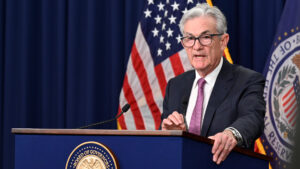By Sehoon Kim, University of Florida
The Federal Reserve raised interest rates again on May 3, by a quarter point, making it the Fed’s 10th rate hike since March 2022 in an ongoing fight to tame inflation. These rate hikes have been reverberating through the economy, raising prospects of a recession amid heightened concerns about the fragile state of banks.
The rate hikes are also rattling sustainability-focused investing, better known as ESG investing.

The trend toward ESG investing, which puts pressure on companies to meet environmental, social and governance benchmarks, has almost redefined asset management over the past decade. ESG funds today are a multitrillion-dollar market.
However, the high uncertainty around interest rates today, along with the prospects of a looming recession and a political backlash, has put the future of ESG investors at a crossroads.
I specialize in sustainable finance, and my recent work has documented the impact that tough economic times can have on ESG investing demand. Investments into U.S. sustainable mutual funds have visibly slowed since 2022, suffering their worst net flows in five years. Here are how three critical factors can affect investors’ zeal for socially conscious investing going forward.
Interest rate uncertainty
One of the primary arguments that big institutional investors like BlackRock make for ESG investing is that it creates long-term value for shareholders. Companies that pay careful attention to environmental, social and governance issues are believed to be better prepared for distant future risks, including regulatory risks and physical risks from climate change.

However, heightened uncertainty about interest rates poses a challenge today. That’s because higher rates can disproportionately affect the present value that investors assign to long-term investment outcomes. Let me explain.
Within the past year, the Federal Reserve has raised its benchmark lending rate from almost zero to a target range of 5% to 5.25% to combat inflation. In financial markets, higher interest rates lead to higher discount rates. That means that future cash generated by long-term investments is considered to be worth considerably less at today’s higher interest rates.
The more distant an asset’s value lies in the future, the more heavily it will be discounted in value when rates are high. So, long-duration investments – like most ESG investments – are especially sensitive to changes in interest rates.
This economic mechanism was also part of the backdrop of the recent rout in tech stocks and the series of bank failures that started with the collapse of Silicon Valley Bank.
Looming recession
Another factor that could affect ESG investing is the potential for an economic downturn.
As research shows, investors do not necessarily make ESG investments for greater long-term returns, but often for altruistic reasons or due to personal preferences to hold greener assets. For these ESG investors, a looming recession could change their perspective on these “luxuries.”
In an early warning about this possibility, a recent study I conducted with an economist at the Rotterdam School of Management found that retail investors showed signs of shying away from investing in sustainable mutual funds during the early months of the COVID-19 shock in 2020. This was a period when many households experienced layoffs and furloughs, which likely pushed them to set aside luxuries to prioritize protecting the values of their 401(k)s, IRAs and other investment portfolios.
In other words, investors may be all for ESG, except when times are tough.
Prominent economists, such as former Treasury Secretary Larry Summers, have warned of a likely recession as inflation and the Fed’s battle against it persist. The International Monetary Fund also lowered its global economic growth outlook from 3.4% in 2022 to 2.8% in 2023.
Political backlash
Finally, recent political friction and anti-ESG policies across states have started to create headwinds for pension funds and large institutions that serve them.
For example, Florida and Kansas passed laws in recent weeks and several other states including Texas and Kentucky have taken actions to restrict the ability of state public pension funds to invest in companies based on their ESG performance, citing concerns about fraudulent greenwashing and potential fiduciary duty violations, referring to the obligation institutional investors have to seek the highest returns for the lowest risk possible.
These restrictions can severely limit the capacity for ESG investing by institutional investors, which have played a significant role in driving the growth of ESG investing.
While concerns about greenwashing and high fees in ESG investing are not totally unwarranted, these political interventions can also have unintended consequences.
A recent study from economists at Wharton and the Federal Reserve Bank of Chicago found that a Texas law enacted in 2021 prohibiting municipalities from contracting with banks with ESG policies had a distorting side effect on those municipalities’ borrowing costs. The policy ended up raising the cost of public finance, meaning the law ultimately cost taxpayers.
Navigating the crossroads
As companies hold their 2023 annual meetings, the discussions among corporate officials, investors and stakeholders will serve as an important barometer for the current state and future of ESG investing.
Due to high interest rate uncertainty, prospects of a recession and political upheaval, ESG is under pressure. Perceived in recent years as a paradigm shift in how market mechanisms can address harms to society, stakeholders are now scrutinizing ESG investing with a critical lens regarding how strongly it can persist and how much impact it can have.
The next few years will be its most important stress test yet.![]()
Sehoon Kim is an assistant professor of finance at the University of Florida.
This article is republished from The Conversation under a Creative Commons license. Read the original article.



